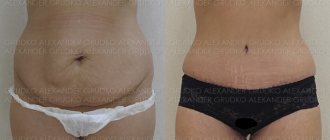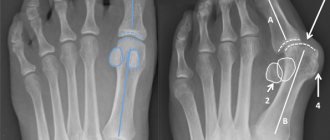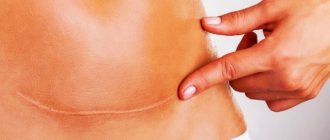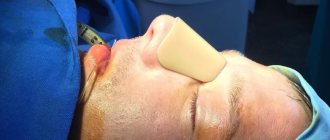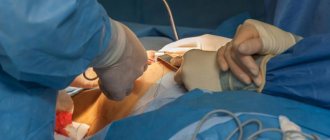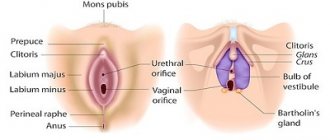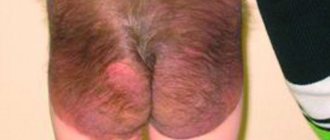For many patients with varicose veins, surgery to remove veins is scary: if the veins are removed or ligated, how will blood circulate in the vessels of the legs? In fact, only a tenth of the blood circulates through the veins located under the skin - the same ones that form unaesthetic varicose veins. Removing superficial veins does not create noticeable additional stress on the deep veins.
Recovery after surgery to remove varicose veins on the legs should be comprehensive, its goal is to prevent complications of the disease, relapses, and return the patient to work and usual activities as soon as possible. The measures that form the recovery program after surgery depend on the degree of neglect of the disease, the nature of the operation, as well as the general condition of the patient and the characteristics of his body.
How relevant, in your opinion, is surgical treatment of varicose veins today?
Phlebectomy, of course, is relevant, if only because we often encounter advanced forms of varicose veins: people do not always see a doctor on time. This is the first point. Second, surgery is necessary if the patient has certain characteristics of the veins, for example, they are very wide or very tortuous. Then it will not be possible to cure varicose veins using any other methods: neither sclerotherapy nor laser will guarantee that the lumen of the vein is completely closed.
The third important point when we can recommend surgery is a large number of lateral tributaries near the main vein. They can be removed using minimally invasive methods, but this takes a lot of time, which is difficult for the patient. It is in his interests to agree to the operation.
Why does the number of operations performed on leg veins increase every year?
The development of varicose veins is facilitated by such “bad” habits of a modern person spoiled by civilization, such as:
- sedentary lifestyle (contractions of the lower leg muscles promote the outflow of blood from the veins of the lower extremities - this is the so-called “second heart”);
- overweight (in the USA, where obesity has become a national problem, 25-30% of the adult population suffers from varicose veins of the legs);
- professions associated with prolonged standing or sitting (long stay at the computer, especially if you have a bad habit of crossing your legs, can also lead to varicose veins).
The initial stages of the disease are often completely asymptomatic, while conservative therapy is not able to restore pathologically stretched veins and deformed venous valves. Therefore, doctors often recommend vein removal to patients already at the first visit.
Indications for surgery
An indication for surgery to remove varicose veins can be any manifestation of the disease that reduces the patient’s quality of life, including:
- disturbances in the functioning of the valve apparatus identified at a doctor's appointment in combination with stretching of the wall of the saphenous veins (this is the main criterion that conservative therapy is no longer effective);
- thrombosis of the saphenous vein (thrombophlebitis);
- symptoms of venous insufficiency (night cramps in the calf muscles, pain and feeling of heaviness in the legs, swelling), which do not respond well to conservative therapy;
- the presence of trophic ulcers of venous etiology (when there is “feeding” of the ulcer by an enlarged vein);
- aesthetic defect (dilated veins in the legs are an unattractive sight).
An operation to eliminate varicose veins can be carried out using various methods, which differ significantly in the volume of intervention, and, consequently, in the consequences for the body.
When choosing a technique, surgeons focus mainly on the stage of the process, so it is better not to wait for complications to develop, but to agree to remove veins in a timely manner.
When surgery should not be performed
The operation to remove varicose veins on the lower extremities is not an extremely dangerous surgical procedure for the body. However, vein removal should be postponed in the presence of acute diseases (influenza, ARVI, etc.), as well as in case of exacerbation of any chronic pathology.
In addition, removal of varicose veins of the lower extremities may be delayed during pregnancy and childbirth. After childbirth, the veins often take on a normal appearance. This occurs during the first 4-5 months after birth.
It must be said that there are no absolute contraindications to surgery to eliminate varicose veins. In cases where varicose veins pose a real threat to the patient’s life and are difficult to treat, vein removal surgery is performed at any age and in any condition of the body (obesity, high blood pressure, etc.).
Minimally invasive operations for varicose veins of the lower extremities
Minimally invasive operations for varicose veins do not involve mechanical removal of venous vessels. The main mechanism of action of these procedures is a chemical (special solution) or physical (laser, high-frequency radiation) effect on the inner lining of the vein. As a result, varicose veins collapse and become overgrown.
Minimally invasive surgeries performed according to indications have the following advantages:
- high efficiency (relapses occur extremely rarely);
- no need for hospitalization;
- absence of gross traumatic effects on the body;
- good tolerance of the procedure by patients;
- minimal percentage of complications and unpleasant side effects;
- shortest recovery period;
- no need for general anesthesia (pain is comparable to dental treatment).
Today there are several methods of minimally invasive intervention, which you can read about below.
Advantages and disadvantages of vein removal using sclerotherapy
The sclerotherapy method is based on chemical gluing of the inner walls of veins by introducing a special substance – sclerosant. The advantages of the method include the relatively low cost of vein removal.
However, if the process is widespread, several sessions of sclerotherapy may be needed - the treatment process can take up to 1 month.
At our clinic, we use sclerotherapy to remove superficial small veins and spider veins (reticular varicose veins).
In addition, sclerotherapy can be used as a combined technique for extensive lesions in combination with laser obliteration or RFO and miniphlebectomy.
Sclerotherapy is also the optimal method for treating trophic ulcers, when the skin over the vein is changed and incisions cannot be made. In such cases, we use the injection of sclerosant into the vein feeding the ulcer under ultrasound control.
Our clinic uses the foaming agent ethoxysklerol as a sclerosant; this method guarantees high efficiency, since the sclerosing agent spreads better throughout the affected vessel.
Read more about sclerotherapy ->
Advantages of vein removal using endovenous laser obliteration
Endovenous laser obliteration (EVLO) is a minimally invasive method for removing varicose veins of the lower extremities using a laser beam.
Compared to sclerotherapy, EVLO has the following advantages:
- absolute painlessness (the procedure is performed under local anesthesia);
- high accuracy (all surgical procedures are performed under ultrasound control);
- according to indications, EVLO can be supplemented with a miniphlebectomy procedure (removal of dilated ducts), this possibility significantly reduces the list of indications for mechanical removal of veins;
- bruises occur less frequently after the procedure;
- postoperative pain syndrome is less pronounced;
- absence of pigment spots at injection sites;
- shorter recovery period.
Read more about laser treatment of varicose veins ->
Radiofrequency ablation is the most modern method of minimally invasive treatment of varicose veins
The advent of radiofrequency ablation (radiofrequency obliteration, RFO) has significantly reduced the number of cases where the only method of solving the problem was surgical (mechanical) removal of varicose veins.
Using a radiofrequency electrode, which is inserted into the vein cavity under ultrasound guidance, it is possible to “brew” large venous trunks with a diameter of 15 mm or more.
Radiofrequency obliteration has all the advantages of EVLO. Moreover, RFO is superior to endovasal laser obliteration in the following indicators:
- use of disposable electrodes;
- full automation of the process, allowing you to avoid annoying errors (the device is equipped with a sensor and operates using a feedback method, so that with a larger vessel width, more energy is automatically sent);
- the procedure takes significantly less time;
- after a year, the vein treated with RFO completely resolves (when using EVLO, it remains in the form of a cord).
The only disadvantage of radiofrequency ablation is the high cost of the procedure.
More details ->
Surgery to remove varicose veins on the lower extremities
Phlebectomy or surgical removal of varicose veins is a more radical surgical intervention that involves complete or partial removal of the affected venous trunk (great or small vein) along with all its branches, as well as ligation of the anastomosis with the deep veins of the limb.
Phlebectomy is performed in more advanced cases, and therefore is often complemented by the use of minimally invasive methods to remove remaining branches and varicose veins.
The postoperative period after phlebectomy is usually longer than in the case of minimally invasive interventions. Postoperative wounds remain on the operated leg, which require careful care.
Minor bruises and extensive hematomas after phlebectomy are much more common, and inflammatory infiltrates (indurations) often occur.
However, with proper care, all unpleasant side effects completely disappear. Small, inconspicuous scars remain at the incision sites, which, as a rule, do not cause major complaints.
Preparing for surgery
Regardless of the chosen method of surgical treatment, before performing vein removal surgery, you should undergo an examination, which includes standard laboratory tests (general blood and urine tests, coagulogram, blood glucose, etc.).
In addition, you will need an ultrasound of the veins and tests for blood-borne infections (hepatitis, syphilis, HIV).
Be sure to inform your doctor about all medications you are taking (contraceptives, ibuprofen, aspirin, etc.), as well as about cases of allergic reactions to medications.
Consequences of vein removal surgery. How to behave to avoid complications
To avoid the development of thrombotic complications, doctors use special agents - anticoagulants, which are selected depending on the indicators of the blood coagulation system.
After EVLO and RFO, early loading of the legs (walking) is recommended. In cases where the operation was performed by phlebectomy while walking, a transient pain syndrome may occur.
After removing varicose veins, you will need to strictly adhere to the following instructions for a certain time:
- wear compression stockings (stockings are more comfortable);
- refuse thermal procedures (bath with high temperatures, sunbathing on the beach, etc.).
The duration of the restrictions is set by the attending physician depending on the stage of development of the disease, the method of operation, the volume of removed veins, the general condition of the body and the dynamics of the recovery process.
How to avoid relapse
It should be borne in mind that varicose veins occur in people with a hereditary predisposition, therefore, after the operation, everything possible should be done to prevent the disease from returning, namely:
- monitor your own weight;
- avoid prolonged static load;
- undergo treatment courses with venotonics;
- wear compression garments as indicated.
Is it possible to do without surgery?
In cases where irreversible changes have occurred in the wall of the veins, unfortunately, it is impossible to do without surgical intervention. With prolonged development, varicose veins threaten such complications as:
- massive bleeding from dilated veins;
- thrombosis of venous trunks;
- thromboembolic complications (including cardiac arrest, pulmonary infarction, etc.);
- trophic ulcers, etc.
There are no magic ointments that dissolve living tissue (dilated veins). Most of these products have only a local distracting effect, causing a “cooling” feeling when applied. Prevention of thrombosis with ointments without wearing compression stockings is not effective. Treatment of thrombosis as monotherapy is also absolutely ineffective.
Is it possible to postpone vein removal surgery?
Modern methods of vein removal allow you to get rid of the disease in a fairly comfortable way and in the future lead a full life with virtually no restrictions.
If at the moment you do not have the opportunity to have surgery, then the only method that can delay the occurrence of complications is to constantly wear compression hosiery of compression class 2 or 3.
Constantly - this also happens in the summer, when the risk of thrombosis is especially high. Compression hosiery is worn after surgery for 2-3 weeks, after which in most cases you can forget about it.
It should also be taken into account that the later the patient consults a doctor, the more expensive the treatment will be, and in the final stages, traumatic intervention cannot be avoided.
Do not put off the operation for too long. Take care of yourself. Be healthy.
A phlebologist at City Clinical Hospital No. 31 will conduct a thorough examination and select the optimal treatment option using safe modern techniques: drug treatment, sclerotherapy, miniphlebectomy, endovasal laser ablation and others.
Make an appointment with our specialists
You can make an appointment for a fee
see a doctor by calling
the consultation and diagnostic center
, or by filling out the form provided.
Terms of provision of paid services can be found here
Make an appointment under the compulsory medical insurance policy
and
directions
you can call
+7
.
Sign up for a paid appointment
How is phlebectomy performed?
Each operation has several stages. Crossectomy is a step where the target vein that we remove is ligated and thereby cut off from the deep venous system. Next comes the removal of the trunk - stripping. This can be a Babcock stripping, when the vein is cut out using a special probe. Cryostripping can be performed - an operation in which a cryoprobe is inserted into a vein, the vessel is “frozen” to it using nitrous oxide, and the doctor pulls it out. A distinctive feature of cryostripping is that the patient makes only one incision in the groin area. PIN stripping can also be performed, when the vein is “screwed” inward. The last two methods cause less tissue damage.
At the third stage, a miniphlebectomy is performed - the tributaries of the main vein are removed through punctures.
How do the veins of the lower extremities work?
Indeed, if veins are removed, how will the blood flow? Why remove it at all, since there is nothing unnecessary in the body? A fairly common misconception stemming from a complete misunderstanding of venous hemodynamics. This issue should be at least briefly clarified. With varicose veins, venous vessels lose their main function of delivering blood to the overlying parts of the vascular bed. Simply put, blood no longer flows through such veins. A reservoir is formed in varicose veins, an abnormal volume of blood that is deprived of the possibility of normal movement to the heart.
Non-functioning valves and dilated veins
It is this volume of blood, essentially not participating in the blood flow, that causes the symptoms of chronic venous insufficiency:
- Edema.
- Pigmentation
- Eczema.
- Lipodermatosclerosis.
- Ulcer.
Also, stagnation of blood causes thrombosis of the superficial and deep veins. In addition, the abnormal blood volume in varicose veins has a significant negative impact on healthy veins. The venous bed is a system of communicating vessels. Healthy veins, not only superficial, but also deep, under the influence of pathological venous pressure begin to expand and collapse.
How long does the recovery period last?
Usually a week. We recommend that patients stay at home, but not in bed, but semi-active. The first three days you can spend about 40% of the time on your feet, and then you need to start “pacing.” On the seventh day, the stitches are removed and the sick leave is closed. For example, we had a patient who had surgery on both legs in turn. And once he completely went through the recovery period, and the second time he had to go to a work meeting after the operation. This leg recovered worse; there were bruises, although he tried to spare the leg and not put stress on it.
What activities are recommended during the rehabilitation period?
The rehabilitation period begins immediately after the end of the postoperative period, that is, 10 days after the operation. At this point, the sutures have already been removed, the postoperative punctures, if there are no complications, have healed. But the body’s recovery processes continue. In order for recovery to occur as quickly as possible, the doctor adjusts the patient’s lifestyle. During the rehabilitation period it is necessary:
- taking medications prescribed by a phlebologist;
- reasonable physical activity, exercise therapy;
- limb compression;
- work in gentle conditions, limiting heavy physical labor;
- nutrition correction;
- physiotherapy, massage.
Drug therapy in the postoperative period involves taking drugs that increase the tone of the venous walls, improve the rheological properties (fluidity) of blood, and have an anti-edematous effect. The drugs recommended during the rehabilitation period include products based on troxerutin, diosmin, drugs with vitamins C and PP, extracts of ginkgo biloba, and horse chestnut. Preparations of salicylic acid, hirudin, and heparin are used as anticoagulants.
Medicines are prescribed both in the form of general preparations (tablets, capsules for oral administration) and local preparations (gels, ointments for application directly to the skin of the lower extremities). Competent drug therapy during the rehabilitation period can accelerate the restoration of microcirculation and at the same time serves as an effective prevention of relapses of the disease.
Moderate physical activity is necessary to stimulate blood circulation in the lower extremities, prevent its stagnation, and the formation of blood clots. Walking at a moderate pace, swimming, and exercise therapy complexes are recommended as optimal measures to activate the patient. Running during the rehabilitation period is not recommended.
During the rehabilitation period, compression on the legs is mandatory. Compression of the lower extremities is necessary for all patients suffering from varicose veins - it helps prevent the progression of the disease and the development of complications. A phlebologist recommends a compression method and selects the size of elastic underwear.
Gentle working conditions are necessary to prevent relapse of the pathology and its transfer to the deep veins of the legs. Varicose veins are often a consequence of difficult working conditions and the characteristics of professional activity. If your job involves standing for a long time, it may be worth changing it or at least regularly performing therapeutic exercises during the working day aimed at improving blood circulation in the legs. Work in conditions of high temperatures associated with vibration and heavy lifting is contraindicated.
Correction of nutrition after leg vein removal surgery should be directed towards rationalization. Food needs to be complete, healthy, rich in protein, fiber, vitamins and microelements. If you are overweight, you should reduce your caloric intake, since obesity is one of the factors in the progression of varicose veins.
Physiotherapeutic techniques during the rehabilitation period accelerate recovery. A physiotherapeutic treatment program is recommended by a doctor; wraps, electrophoresis, UHF, and magnetic therapy may be useful. Massage during the rehabilitation period helps to effectively eliminate swelling.
Competent management of the postoperative period after removal of dilated veins in the legs, a responsible attitude to the doctor’s recommendations will help eliminate the natural discomfort that occurs after surgery as soon as possible, prevent possible complications and speed up the patient’s return to a full life.
And the last question - what happens if surgery is indicated, but the person does not do it?
I usually say this: “If you don’t deal with the disease, then the disease will deal with you.” If phlebectomy is not performed, varicose veins can lead to thrombophlebitis, and then the veins will have to be removed urgently. Therefore, I recommend that if there are indications for surgery, calmly collect all the tests, prepare and perform it.
Phlebectomy cost:
The main goal of the Phlebology Center clinic is to ensure maximum safety for the patient during surgical treatment. All operations are performed under local anesthesia by surgeons with at least 5 years of experience and only in the presence of an experienced anesthesiologist.
The cost of surgical treatment includes: hospital stay, anesthesia, postoperative dressings, suture removal. After completing the course of treatment, you will receive free six-month observation with ultrasound control.
What may be the consequences after vein removal?
Surgeries to remove varicose veins are quite traumatic interventions that seriously disrupt the internal balance of the body. Therefore, you need to be prepared for certain discomfort in the postoperative period: pain in the intervention area; hematomas at the site of the removed vein and at the sites of sutures on the skin; swelling of the leg at the site of the removed vein and sutures; moderate bleeding of the postoperative wound; general weakness, fever, nausea.
Why do such consequences occur? After removal of veins in the legs, an inflammatory process inevitably occurs in the tissues that previously surrounded the vessel - this is a natural, physiological reaction of the body to the intervention, aimed at healing the damage. Any inflammatory process is accompanied by local swelling and pain, and general symptoms of malaise are possible: nausea, fever, weakness. They disappear a few days after the intervention. Minor bleeding from a postoperative wound should not be a concern either: when a vein is removed, small vessels break off, which then collapse and the flow of blood stops. If you follow the surgeon’s recommendations, the unpleasant phenomena will quickly disappear.
In some cases, after venectomy surgery on the legs, infection of the intervention area, suppuration, thromboembolism, or accumulation of blood in the ligated vein with the development of inflammation of the vessel is possible. But thanks to modern surgical capabilities and the perfection of surgical technology, such complications are extremely rare.
Get an online consultation
right now.
Get
Benefits of minimally invasive leg vein surgery
Phlebologists at the Yusupov Hospital prefer minimally invasive operations for varicose veins of the lower extremities. They have the following advantages:
- Not accompanied by pain;
- Does not require anesthesia;
- The patient is in the hospital for the day of the intervention, then he is sent home.
Most minimally invasive surgeries do not require wearing compression garments or limiting your ability to work. Sometimes patients are advised to use light compression.
